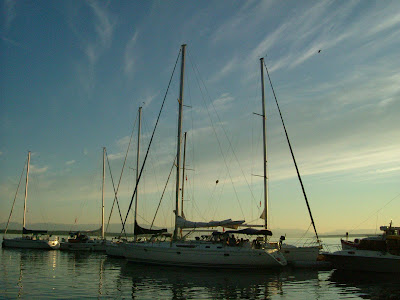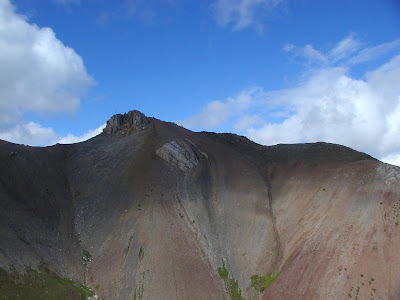The impressive homeotype specimen of a Eurypterus lacustris duo hails from Late Silurian deposits of New York. These lovelies are now housed in UCMP Berkeley's paleontological collections.
About two dozen families of eurypterids “sea scorpions” are known from the fossil record. Although these ancient predators have a superficial similarity, including a defensive needle-like spike or telson at their tail end, they are not true scorpions.
They are an extinct group of arthropods related to spiders, ticks, mites and other extant creepy crawlies.
Eurypterids hunted fish in the muddy bottoms of warm shallow seas before moving on to hunting grounds in fresh and brackish water during the latter part of their reign.
They declined in numbers and diversity until becoming extinct during the Permian–Triassic extinction event (or sometime shortly before) 251.9 million years ago.
As to the oldest and youngest of the order, we can look to the Stylonurina. Members of the suborder are collectively and informally known as "stylonurine eurypterids" or "stylonurines". They are known from deposits primarily in Europe and North America, but also in Siberia.
Compared to the suborder, Eurypterina, the stylonurines were comparatively rare and retained their posterior prosomal appendages for walking. Despite their rarity, the stylonurines have the longest temporal range of the two suborders. The suborder contains some of the oldest known eurypterids, such as Brachyopterus, from the Middle Ordovician as well as the youngest known eurypterids, from the Late Permian.
They remained rare throughout the Ordovician and Silurian, though the radiation of the mycteropoids (a group of large sweep-feeding forms) in the Late Devonian and Carboniferous is the last major radiation of the eurypterids before their extinction in the Permian.

Sunday 31 December 2000
Saturday 30 December 2000
HOPLOSCAPHITES MACROCONCH
This sweet beauty is a Hoploscaphites nebrascensis (Owen, 1852) macroconch, the beautiful large female of the species.
Hoploscaphites nebrescensis is an upper Maastrichtian species and index fossil. It marks the top of ammonite zonation for the Western Interior.
It has been recorded from Fox Hills Formation in North and South Dakota as well as the Pierre Shale in southeastern South Dakota and northeastern Nebraska.
It is unknown from Montana, Wyoming, and Colorado due to the deposition of coeval terrestrial units. It has possibly been recorded in glacial deposits in Saskatchewan and northern North Dakota, but that is hearsay. Outside the Western Interior, this species has been found in Maryland and possibly Texas in the Discoscaphites Conrad zone. Collection of the deeply awesome (and enviable) José Juárez Ruiz.
Hoploscaphites nebrescensis is an upper Maastrichtian species and index fossil. It marks the top of ammonite zonation for the Western Interior.
It has been recorded from Fox Hills Formation in North and South Dakota as well as the Pierre Shale in southeastern South Dakota and northeastern Nebraska.
It is unknown from Montana, Wyoming, and Colorado due to the deposition of coeval terrestrial units. It has possibly been recorded in glacial deposits in Saskatchewan and northern North Dakota, but that is hearsay. Outside the Western Interior, this species has been found in Maryland and possibly Texas in the Discoscaphites Conrad zone. Collection of the deeply awesome (and enviable) José Juárez Ruiz.
Wednesday 27 December 2000
Friday 10 November 2000
Friday 20 October 2000
Cedar: Lifeblood to an Island

Tsyyaaay: The arrival of cedar, called “Tsuuaay” by the Haida, had profound effects on the material culture of the Haida (Approx 4000 BC). Once they were able to build canoes to fish year round (Halibut, Red Snapper, Ling Cod etc) and could access sea mammals, they no longer only depended on the salmon to return at certain times. The cedar bent wood box, a genius idea in food conservation and storage, allowed them to store food for the winter and reduced their dependence on hunting land mammals throughout the year wained.
Birth of a New Tradition: The arrival of cedar marked a whole new stone tool tradition. The micoblades are abandoned for larger ground tools, which are more appropriate for working with cedar.
Tuesday 11 July 2000
Tuesday 4 July 2000
Thursday 29 June 2000
PALEONTOLOGY AND GEOLOGY OF WASHINGTON
The Precambrian: Precambrian rocks exist only along the northeastern portion of the state. Since the Precambrian, huge amounts of crust have been added to the western edge of the North American continent.
All the land west of the Precambrian rocks has been created through complex tectonic processes along an active continental margin or transported from elsewhere and accreted onto the continent of this region.
Paleozoic: In the early Paleozoic, easternmost Washington was at the edge of a large ocean. Early Paleozoic fossiliferous sandstone, shales, and limestone were deposited along this ancient shoreline.
Other Paleozoic sedimentary rocks of Washington were transported as exotic terranes and accreted to the margin of the continent in the Mesozoic. These terranes contain unrelated slivers of Devonian-, Carboniferous-, and Permian-aged rocks, originally formed far from their present location.
Mesozoic: During the late Jurassic and early Cretaceous, numerous blocks of exotic terranes were added to the western edge of the North American continent to form most of what we know as Washington state today. British Columbia and Oregon are also made up primarily of these terranes. Most of these terranes consist of narrow, banded,rock sequences, often overturned and formed far from their current location —much like a badly shuffled deck of cards.
They include volcanic island rocks and fossiliferous marine sediments that originated elsewhere in the Pacific Ocean. Jurassic and Cretaceous fossils occur in the north-central and northwestern part of the state. By the end of the Mesozoic, approximately two-thirds of the state was assembled.
Cenozoic: Cenozoic marine sediments make up the western part of Washington and were formed as the sea gradually retreated westwards. Marine fossiliferous sandstones and siltstone cover most of Washington west of the Cascades Mountains.
The Olympic Mountains consist of marine sedimentary rocks uplifted about 10 million years ago. The Cascade volcanic began in the mid-Cenozoic and has been active ever since. Continental sedimentary rocks are not common. Continental ice sheets covered the northern third of the state during the late Cenozoic, and alpine glaciers covered the Cascades and Olympic Mountains. Large and small mammals lived at the edge of the ice, and salmon swam up the rivers to ice-blocked dams.
From the paleontological portal: http://www.paleoportal.org/kiosk/sample_site/state_46.html
All the land west of the Precambrian rocks has been created through complex tectonic processes along an active continental margin or transported from elsewhere and accreted onto the continent of this region.
Paleozoic: In the early Paleozoic, easternmost Washington was at the edge of a large ocean. Early Paleozoic fossiliferous sandstone, shales, and limestone were deposited along this ancient shoreline.
Other Paleozoic sedimentary rocks of Washington were transported as exotic terranes and accreted to the margin of the continent in the Mesozoic. These terranes contain unrelated slivers of Devonian-, Carboniferous-, and Permian-aged rocks, originally formed far from their present location.
Mesozoic: During the late Jurassic and early Cretaceous, numerous blocks of exotic terranes were added to the western edge of the North American continent to form most of what we know as Washington state today. British Columbia and Oregon are also made up primarily of these terranes. Most of these terranes consist of narrow, banded,rock sequences, often overturned and formed far from their current location —much like a badly shuffled deck of cards.
They include volcanic island rocks and fossiliferous marine sediments that originated elsewhere in the Pacific Ocean. Jurassic and Cretaceous fossils occur in the north-central and northwestern part of the state. By the end of the Mesozoic, approximately two-thirds of the state was assembled.
Cenozoic: Cenozoic marine sediments make up the western part of Washington and were formed as the sea gradually retreated westwards. Marine fossiliferous sandstones and siltstone cover most of Washington west of the Cascades Mountains.
The Olympic Mountains consist of marine sedimentary rocks uplifted about 10 million years ago. The Cascade volcanic began in the mid-Cenozoic and has been active ever since. Continental sedimentary rocks are not common. Continental ice sheets covered the northern third of the state during the late Cenozoic, and alpine glaciers covered the Cascades and Olympic Mountains. Large and small mammals lived at the edge of the ice, and salmon swam up the rivers to ice-blocked dams.
From the paleontological portal: http://www.paleoportal.org/kiosk/sample_site/state_46.html
Monday 29 May 2000
Wednesday 24 May 2000
Monday 15 May 2000
Friday 21 April 2000
Thursday 3 February 2000
Thursday 27 January 2000
Thursday 13 January 2000
EURYPTERUS LACUSTRIS
The impressive homeotype specimen of a Eurypterus lacustris duo hails from Late Silurian deposits of New York. These lovelies are now housed in UCMP Berkeley's paleontological collections.
About two dozen families of eurypterids “sea scorpions” are known from the fossil record. Although these ancient predators have a superficial similarity, including a defensive needle-like spike or telson at their tail end, they are not true scorpions.
They are an extinct group of arthropods related to spiders, ticks, mites and other extant creepy crawlies.
Eurypterids hunted fish in the muddy bottoms of warm shallow seas before moving on to hunting grounds in fresh and brackish water during the latter part of their reign.They declined in numbers and diversity until becoming extinct during the Permian–Triassic extinction event (or sometime shortly before) 251.9 million years ago. As to the oldest and youngest of the order, we can look to the Stylonurina. Members of the suborder are collectively and informally known as "stylonurine eurypterids" or "stylonurines". They are known from deposits primarily in Europe and North America, but also in Siberia.
Compared to the suborder, Eurypterina, the stylonurines were comparatively rare and retained their posterior prosomal appendages for walking. Despite their rarity, the stylonurines have the longest temporal range of the two suborders. The suborder contains some of the oldest known eurypterids, such as Brachyopterus, from the Middle Ordovician as well as the youngest known eurypterids, from the Late Permian. They remained rare throughout the Ordovician and Silurian, though the radiation of the mycteropoids (a group of large sweep-feeding forms) in the Late Devonian and Carboniferous is the last major radiation of the eurypterids before their extinction in the Permian.
About two dozen families of eurypterids “sea scorpions” are known from the fossil record. Although these ancient predators have a superficial similarity, including a defensive needle-like spike or telson at their tail end, they are not true scorpions.
They are an extinct group of arthropods related to spiders, ticks, mites and other extant creepy crawlies.
Eurypterids hunted fish in the muddy bottoms of warm shallow seas before moving on to hunting grounds in fresh and brackish water during the latter part of their reign.They declined in numbers and diversity until becoming extinct during the Permian–Triassic extinction event (or sometime shortly before) 251.9 million years ago. As to the oldest and youngest of the order, we can look to the Stylonurina. Members of the suborder are collectively and informally known as "stylonurine eurypterids" or "stylonurines". They are known from deposits primarily in Europe and North America, but also in Siberia.
Compared to the suborder, Eurypterina, the stylonurines were comparatively rare and retained their posterior prosomal appendages for walking. Despite their rarity, the stylonurines have the longest temporal range of the two suborders. The suborder contains some of the oldest known eurypterids, such as Brachyopterus, from the Middle Ordovician as well as the youngest known eurypterids, from the Late Permian. They remained rare throughout the Ordovician and Silurian, though the radiation of the mycteropoids (a group of large sweep-feeding forms) in the Late Devonian and Carboniferous is the last major radiation of the eurypterids before their extinction in the Permian.
Subscribe to:
Posts (Atom)












+Henderson+in+Quatsino+Sound+2001.jpg)

